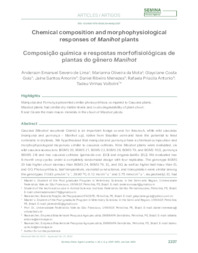Chemical composition and morphophysiological responses of Manihot plants.
Chemical composition and morphophysiological responses of Manihot plants.
Author(s): LIMA, A. E. S. de; MOTA, M. O. da; GOIS, G. C.; AMORIM, J. S.; MENEZES, D. R.; ANTONIO, R. P.; VOLTOLINI, T. V.
Summary: Cassava (Manihot esculenta Crantz) is an important forage source for livestock, while wild cassavas (maniçoba and pornunça ? Manihot sp.), native from Brazilian semi-arid have the potential to feed ruminants in drylands. We hypothesized that maniçoba and pornunça have a chemical composition and morphophysiological responses similar to cassava cultivars. Nine Manihot plants were evaluated, six wild cassava accessions (BGMS 20, BGMS 21, BGMS 22, BGMS 26, BGMS 79, and BGMS 102), pornunça (BGMS 24) and two cassava cultivars (gema-de-ovo [GO] and engana-ladrão [EL]). We evaluated two 6-month crop cycles under a completely randomized design with four replicates. The genotype BGMS 20 had higher shoot biomass than BGMS 24, BGMS 79, EL, and GO, as well as higher leaf mass than EL and GO. Photosynthesis, leaf temperature, stomatal conductance, and transpiration were similar among the genotypes (13.83 ?mol.m-2.s-1, 29.90 ºC, 0.12 mol.m-2.s-1 and 2.75 mmol.m-2.s-1, respectively). EL had a shoot crude protein content higher than the others, except for BGMS 21 and BGMS 24. Genotypes did not differ concerning in situ and in vitro (dry matter (DM)) degradability and mineral composition. BGMS 24 had a higher number of leaves than the others, and BGMS 20 had taller plants than the other genotypes, except for BGMS 21 and BGMS 22. In vitro gas production was similar among the genotypes considering total carbohydrates. Wild cassava accessions showed shoot biomass, leaf mass physiological responses, and chemical composition compatible with cassava cultivars; therefore, they show potential as alternative forages for livestock.
Publication year: 2022
Types of publication: Journal article
Unit: Embrapa Semi-arid Region
Observation
Some of Embrapa's publications are published as ePub files. To read them, use or download one of the following free software options to your computer or mobile device. Android: Google Play Books; IOS: iBooks; Windows and Linux: Calibre.
Access other publications
Access the Agricultural Research Database (BDPA) to consult Embrapa's full library collection and records.
Visit Embrapa Bookstore to purchase books and other publications sold by Embrapa.

